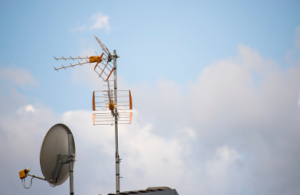Antennas can provide a convenient means for receiving a quality signal from television broadcast towers; however, their performance depends heavily on how it was installed.

Installing either an indoor or outdoor antenna requires following some essential guidelines to ensure maximum performance and enjoyment from both.
Installation Methods
Television antenna installation techniques vary depending on their type and where they need to be placed. For example, indoor TV antennas may need to be located near a television set; mounted versions will likely require installation on walls or windows; long-range outdoor antennas must be assembled and placed inside the attic/roof of your house or mounted externally with a mast support.
Once an antenna has been installed, it must be properly aligned to receive the strongest TV signal possible. While this may prove tricky initially, the practice should produce relatively good results.
Locating the closest broadcast towers will produce optimal TV signal reception. Still, it is important not to position your antenna directly in line with it, as this could lead to signal loss. Instead, aim for placing at least double the length of the mast away from power lines and keep in mind hazard avoidance measures are ideal.
As another way of improving reception, antennainstallationsAdelaide.com.au TV antenna installation can also help enhance it. For example, if your antenna is mounted on a long mast, using galvanized steel guy wires will prevent swaying that could disrupt signal interference and degrade reception.
Once your antenna is in its optimal position, it must be connected to your TV via coaxial cable or, if applicable, via an external tuner box. Once done, run its coaxial cable from your antenna back to your TV to view TV programmes.
Antennas
An antenna can effectively save money on cable or satellite bills, but you must determine what best meets your needs before purchasing.
Consider your room’s size and signal requirements before placing an antenna. For instance, in an apartment building with small windows, it may be wise to position the antenna near as close to them as possible for optimal performance.
Try different antenna placements to achieve maximum reception. For instance, if obstructions exist between your antenna and the broadcast tower, try mounting it higher or in an elevated outdoor location.
Consider also how the weather might impact your antenna over time, such as living near the beach where salt air may cause an outdoor antenna to corrode quickly or the presence of trees that cast shadows onto it could interfere with reception.
Masts
A mast that suits their installation must be selected when installing TV antennas. A suitable mast must be tall and sturdy to not harm or interfere with the reception of television signals.
Masts may be constructed of materials, including steel lattices or tubular guyed masts. While open-body masts offer greater wind resistance than their closed counterparts, guyed masts are more robust and provide additional wind protection.
Small towers made of concrete may also be less intrusive on the landscape. These can be used for shortwave broadcasting and may also be designed aesthetically.
Masts may also be installed in lofts and attics, where their dry conditions and higher elevation can help extend antenna longevity. A chimney may also provide an option, although you should ensure it remains secure without leaks.
Wall Mounts
A wall-mounted antenna is an ideal solution to reduce the hassle and expense of a cable or satellite TV subscription. They tend to be relatively inexpensive and come equipped with several features.
Most wall mounts can be secured directly into drywall using screws or bolts and come equipped with all the hardware and instructions for safe installation. Before beginning drilling and screwing operations on any of your walls, use a stud finder to locate all studs before beginning drilling or screwing operations.
Specific mounts feature built-in levels to assist with placing and aligning your television before drilling it into drywall, providing safety and aesthetic advantages; you don’t want an unattractive television!
Professional Installation
Antennas offer an easy way to access over-the-air TV signals without paying for cable service, but successful installation requires knowledge about antennas and broadcast towers in your area.
An experienced antennainstallationsAdelaide.com.au TV antenna professional can assist in selecting an outdoor antenna that will offer optimal reception in your location. They know how to position it and manage nearby structures or obstacles to ensure optimal results.
Installation of a TV antenna may be possible if you feel comfortable working with ladders and tools; however, professionals are generally the safer option for this task. In addition, antennas on roofs and attics present potential safety issues, risking irreparable roof damage from improper installations.